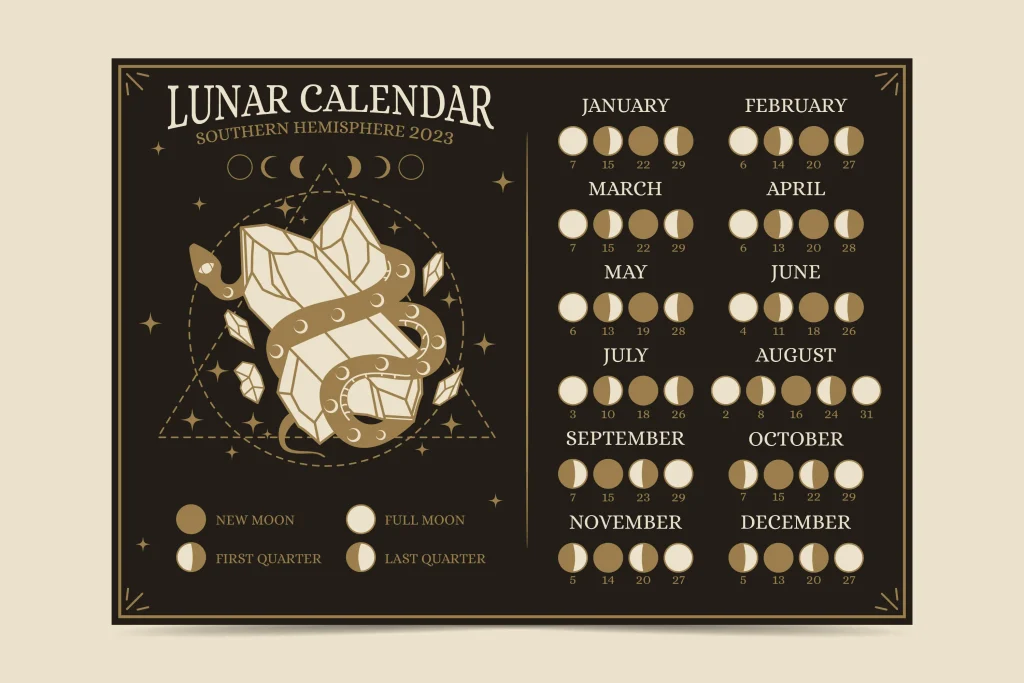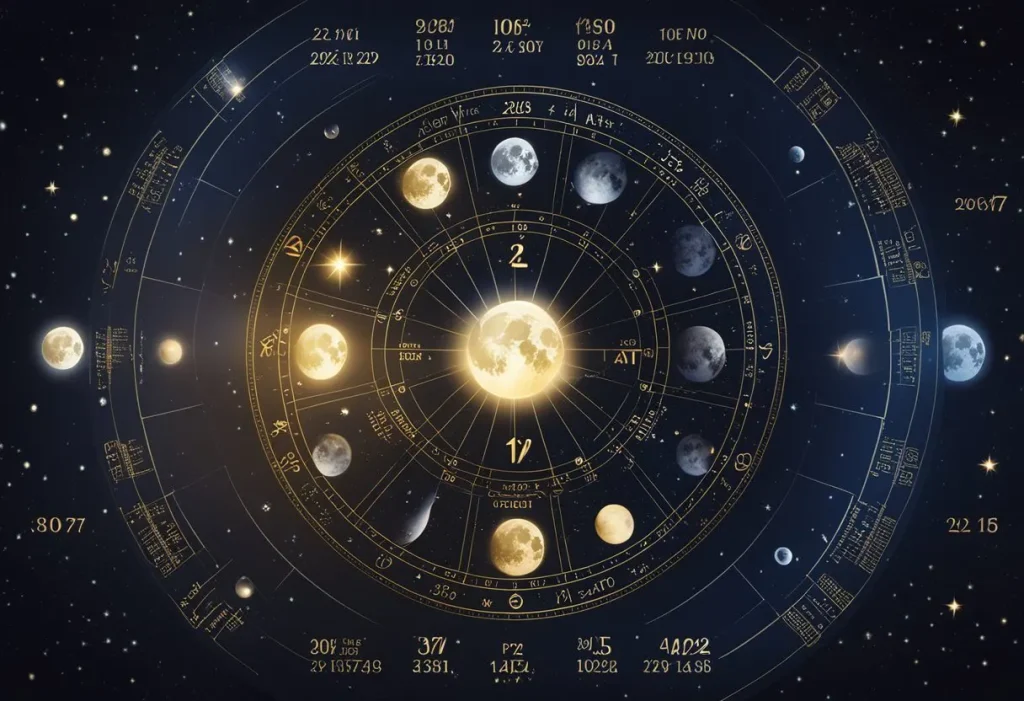Lunar Calendar 2024: Important Dates and Events to Look Out For
The lunar calendar is a fascinating and ancient system of timekeeping that has been used for centuries in many cultures around the world. In 2024, it will continue to be an important tool for those who follow lunar cycles and wish to stay in tune with the natural rhythms of the universe. This article will provide an overview of the lunar calendar for 2024, including its basics, cultural and historical significance, and practical applications.

It is based on the cycles of the moon, with each month beginning with the new moon and ending with the full moon. Unlike the Gregorian calendar, which is based on the solar year, the lunar calendar is based on the lunar month, which is approximately 29.5 days long. As a result, the it has 12 months of 29 or 30 days each, for a total of 354 or 355 days in a lunar year.
The lunar calendar has been used for centuries in many cultures around the world, including China, India, and the Islamic world. It has been used for everything from agricultural planning to religious observances, and has played a significant role in the development of many cultures. In 2024, it will continue to be an important tool for those who wish to stay in tune with the natural rhythms of the universe, and will provide a fascinating glimpse into the rich cultural and historical significance of this ancient system of timekeeping.
Key Takeaways
- The lunar calendar is an ancient system of timekeeping based on the cycles of the moon.
- Unlike the Gregorian calendar, which is based on the solar year, it is based on the lunar month.
- This calendar has been used for centuries in many cultures around the world, and will continue to be an important tool for those who wish to stay in tune with the natural rhythms of the universe.
Basics of the Lunar Calendar 2024

The Lunar Calendar 2024 is a calendar that follows the cycles of the Moon. It is based on the synodic period of the Moon, which is the time it takes for the Moon to return to the same phase (e.g. full moon to full moon). It is used in many cultures for religious and agricultural purposes.
Phases of the Moon
The Lunar Calendar 2024 is based on the phases of the Moon, which are the different appearances of the Moon as seen from Earth. There are eight main phases of the Moon: New Moon, Waxing Crescent, First Quarter, Waxing Gibbous, Full Moon, Waning Gibbous, Third Quarter, and Waning Crescent. These phases are determined by the position of the Moon relative to the Sun and the Earth.
Month Synodic Period
The Lunar Calendar 2024 is based on the synodic period of the Moon, which is the time it takes for the Moon to return to the same phase. The synodic period of the Moon is approximately 29.5 days, which is why most lunar months have 29 or 30 days. However, the Lunar Calendar 2024 has 13 lunar months, with an extra month added every two or three years to keep the calendar in sync with the solar year.
Leap Months
The extra month added to the Lunar Calendar 2024 is called a leap month. The leap month is added to the lunar year to keep the calendar in sync with the solar year. The leap month is added after the 12th month and is designated as either a first or second leap month. The decision to add a leap month is made by the Chinese calendar authority based on astronomical observations.
In summary, the Lunar Calendar 2024 is a calendar that follows the cycles of the Moon. It is based on the synodic period of the Moon and has 13 lunar months with an extra month added every two or three years to keep the calendar in sync with the solar year. The Lunar Calendar 2024 is used for religious and agricultural purposes in many cultures.
Cultural and Historical Significance
The Lunar Calendar is an important part of many cultures, including Chinese, Korean, and Vietnamese. It is based on the cycles of the moon and is used to determine important dates such as traditional festivals, agricultural practices, and astrological uses. The year 2024 marks the start of the Lunar New Year on February 10th.
Traditional Festivals
The Lunar Calendar is used to determine many traditional festivals. For example, the Chinese New Year, also known as the Spring Festival, is celebrated on the first day of the Lunar New Year. This festival is celebrated for 15 days and is a time for families to get together, exchange gifts, and eat traditional foods such as dumplings and rice cakes.
Similarly, the Korean New Year, also known as Seollal, is celebrated on the first day of the Lunar New Year. This festival is also a time for families to get together and eat traditional foods such as tteokguk, a soup made with rice cake and beef broth.
Agricultural Practices
The Lunar Calendar is also used to determine important agricultural practices. For example, the Chinese Lunar Calendar is used to determine the best time to plant and harvest crops. This is because the it is based on the cycles of the moon, which are believed to have an effect on the growth of crops.
Similarly, the Vietnamese Lunar Calendar is used to determine the best time to fish and hunt. This is because it is also believed to have an effect on the behaviour of animals.
Astrological Uses
The Lunar Calendar is also used for astrological purposes. For example, the Chinese Zodiac is based on the it and is used to determine a person’s personality traits based on the year they were born. Each year is associated with a different animal, such as the Year of the Rat or the Year of the Ox.
Similarly, the Korean Zodiac is also based on the Lunar Calendar and is used to determine a person’s personality traits based on the year they were born. Each year is associated with a different animal, such as the Year of the Tiger or the Year of the Rabbit.
Overall, the it is an important part of many cultures and is used to determine important dates such as traditional festivals, agricultural practices, and astrological uses.
Conclusion
It is an excellent tool for anyone interested in astrology or the phases of the moon. With its detailed information on the moon’s phases, the calendar can help people understand how the moon affects their lives and emotions.
Throughout the year, there will be several significant lunar events, such as eclipses, new moons, and full moons. These events can have a profound impact on people’s lives, and the it can help them prepare for these events.
It is worth noting that the it is not just for those interested in astrology. The calendar can also be a useful tool for farmers, fishermen, and anyone who works outdoors. The moon’s phases can affect the tides, and the calendar can help people plan their work around these changes.
Overall, the Lunar Calendar is an informative and useful tool that can help people understand the moon’s phases and how they affect their lives. Whether you are interested in astrology or just want to plan your work around the moon’s cycles, the Lunar Calendar 2024 is an excellent resource.


